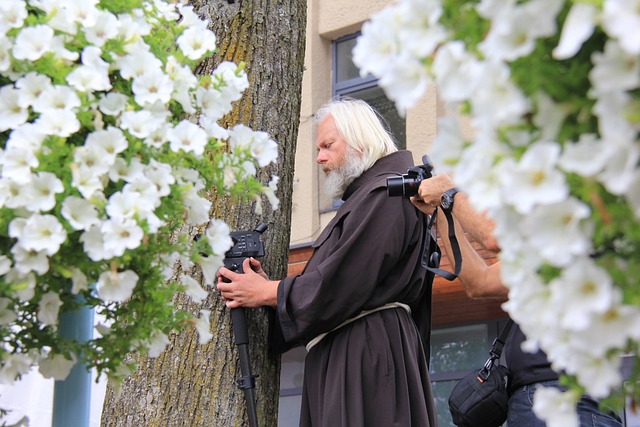A cassock is a long, ankle-length robe worn by clergy members in the Catholic Church. It is typically black in color and is considered a symbol of religious devotion and humility. The cassock is worn by priests, deacons, and other clergy members during religious ceremonies and services.
Table of Contents
History of the Cassock in the Catholic Church
Have you ever wondered what those long, flowing robes worn by Catholic priests are called? They are called cassocks, and they have a long history in the Catholic Church. The cassock is a symbol of the priest’s commitment to serving God and the Church, and it has been worn by clergy for centuries.
The history of the cassock dates back to the early days of the Church. In the early centuries of Christianity, priests and other clergy members wore simple tunics and robes that were similar to those worn by the general population. However, as the Church grew and developed its own distinct identity, the clergy began to adopt more formal and distinctive attire.
One of the earliest forms of the cassock was the “tunic” worn by Roman citizens in ancient times. This garment was a long, loose-fitting robe that was typically worn over a tunic or undergarment. Over time, the tunic evolved into the cassock, which became a symbol of the priest’s dedication to serving God and the Church.
The cassock has undergone many changes and variations over the centuries, but its basic design has remained relatively consistent. The traditional cassock is a long, black robe that reaches to the ankles and is fastened at the waist with a belt or sash. It is typically worn with a white clerical collar and sometimes a surplice or other vestments.
In addition to its symbolic significance, the cassock also serves practical purposes for the clergy. The long, flowing robe is easy to move in and allows the priest to perform his duties with ease and grace. It also helps to distinguish the clergy from the laity and serves as a visual reminder of the priest’s role in the Church.
Today, the cassock is still worn by many Catholic priests, especially during formal ceremonies and religious services. While some priests may choose to wear more modern or casual attire in their day-to-day lives, the cassock remains an important symbol of their commitment to their faith and their vocation.
In recent years, there has been some debate within the Church about the role of the cassock and whether it is still relevant in modern times. Some argue that the cassock is outdated and no longer necessary, while others believe that it is an important symbol of tradition and continuity in the Church.
Ultimately, the decision to wear a cassock is a personal one for each priest. Some may choose to wear it as a sign of their commitment to their faith and their role in the Church, while others may prefer more modern or casual attire. Whatever their choice, the cassock will always be a symbol of the rich history and tradition of the Catholic Church.
Symbolism and Meaning of the Cassock
Have you ever wondered about the significance of the cassock worn by Catholic clergy members? The cassock is a traditional garment that holds deep symbolism and meaning within the Catholic Church. In this article, we will explore the history and significance of the cassock, shedding light on its importance in the Catholic faith.
The cassock, also known as a soutane, is a long, ankle-length robe worn by clergy members in the Catholic Church. It is typically black in color, although some clergy members may wear cassocks of different colors depending on their rank or the occasion. The cassock is a symbol of the clergy’s commitment to their vocation and their dedication to serving God and the Church.
The origins of the cassock can be traced back to the early days of the Catholic Church. In the early centuries of Christianity, clergy members wore simple tunics or robes as a sign of their dedication to their faith. Over time, the cassock evolved into the distinctive garment that we see today, with its long, flowing design and buttoned-up front.
One of the key symbolic meanings of the cassock is its representation of humility and simplicity. By wearing a plain, unadorned garment, clergy members are reminded of the importance of humility and service in their vocation. The cassock serves as a visual reminder of the clergy’s commitment to living a life of simplicity and devotion to God.
In addition to its symbolic meaning, the cassock also serves a practical purpose within the Catholic Church. The cassock is a practical garment that allows clergy members to move freely and comfortably during religious ceremonies and services. Its long, flowing design is well-suited for the formal and solemn occasions that are a regular part of the Catholic liturgy.
The cassock is also a symbol of the clergy’s authority and status within the Church. In many Catholic traditions, the cassock is worn by clergy members of a certain rank or status, such as priests, bishops, or cardinals. The color and style of the cassock may vary depending on the clergy member’s rank, with more senior clergy members often wearing cassocks of a different color or design.
Overall, the cassock holds deep symbolic meaning within the Catholic Church. It is a garment that represents the clergy’s commitment to their vocation, their dedication to serving God and the Church, and their humility and simplicity in living out their faith. The cassock is a visual reminder of the clergy’s authority and status within the Church, as well as a practical garment that allows them to move freely and comfortably during religious ceremonies.
In conclusion, the cassock is a garment that carries a rich history and deep symbolism within the Catholic Church. It is a symbol of the clergy’s commitment to their vocation, their humility and simplicity in living out their faith, and their authority and status within the Church. The cassock serves as a visual reminder of the clergy’s dedication to serving God and the Church, and its practical design allows clergy members to move freely and comfortably during religious ceremonies.
Different Styles and Colors of Cassocks

Have you ever wondered what those long, flowing robes worn by Catholic clergy members are called? They are called cassocks, and they have been a traditional garment in the Catholic Church for centuries. Cassocks are not only a symbol of the clergy’s dedication to their faith but also serve a practical purpose in their daily lives.
Cassocks come in a variety of styles and colors, each with its own significance and history. One of the most common styles of cassocks is the Roman cassock, which is a long, black robe that reaches the ankles and is typically worn by priests. The Roman cassock is a symbol of the priest’s commitment to serving God and the Church, and it is often worn during religious ceremonies and services.
Another style of cassock is the choir cassock, which is similar to the Roman cassock but is typically worn by members of the choir or other clergy members who assist in the church’s services. The choir cassock is often worn with a surplice, a white garment worn over the cassock, which symbolizes purity and holiness.
In addition to the traditional black cassocks, there are also cassocks in a variety of colors, each with its own significance. For example, red cassocks are often worn by cardinals, who are high-ranking clergy members in the Catholic Church. The color red symbolizes the blood of Christ and the martyrdom of the saints, and it is a sign of the cardinal’s commitment to serving the Church.
White cassocks are often worn by the Pope, who is the head of the Catholic Church. The color white symbolizes purity and holiness, and it is a sign of the Pope’s role as the spiritual leader of the Church. The Pope’s white cassock is also adorned with gold and silver trim, which symbolizes his authority and status within the Church.
In addition to black, red, and white cassocks, there are also cassocks in other colors, such as purple, green, and blue. These colors are often worn during specific liturgical seasons or events in the Church’s calendar. For example, purple cassocks are worn during Lent, a time of penance and reflection, while green cassocks are worn during Ordinary Time, a period of growth and renewal in the Church.
Overall, cassocks are an important symbol of the Catholic Church’s tradition and history. They not only serve a practical purpose in the clergy’s daily lives but also convey a deeper meaning and significance to those who wear them. Whether black, red, white, or another color, cassocks are a visible reminder of the clergy’s commitment to serving God and the Church.
The Role of the Cassock in Clerical Dress
Have you ever wondered about the significance of the cassock in the Catholic Church? The cassock is a traditional garment worn by clergy members, particularly priests and seminarians. It is a symbol of their commitment to their faith and their role within the church. In this article, we will explore the role of the cassock in clerical dress and its importance in the Catholic Church.
The cassock is a long, ankle-length robe that is typically black in color. It is worn by clergy members during religious services, formal occasions, and everyday activities. The cassock is a symbol of the clergy’s dedication to their vocation and their willingness to serve the church and its members. It is a visible reminder of their commitment to God and their role as spiritual leaders within the community.
In addition to its symbolic significance, the cassock also serves a practical purpose. It is a practical and comfortable garment that allows clergy members to move freely and perform their duties with ease. The cassock is designed to be simple and unadorned, reflecting the humility and modesty that are valued within the Catholic Church.
The cassock is often worn with a white clerical collar, which is a symbol of the clergy’s authority and status within the church. The clerical collar is a distinctive feature of clerical dress and is worn by priests, deacons, and bishops. It is a symbol of their ordination and their role as spiritual leaders within the church.
The cassock is also worn with a sash or belt, which is used to cinch the garment at the waist. This helps to give the cassock a more tailored and polished look, while also providing a practical way to adjust the fit of the garment. The sash or belt is often made of silk or other fine fabrics, adding a touch of elegance to the overall ensemble.
In addition to its practical and symbolic significance, the cassock is also a way for clergy members to express their personal style and identity. While the basic design of the cassock is consistent across the Catholic Church, there are variations in style and color that allow clergy members to personalize their garments and make them their own.
Some clergy members choose to wear a cassock with a colored sash or belt, while others may opt for a more traditional black and white ensemble. Some clergy members also choose to wear a cassock with decorative buttons or other embellishments, adding a touch of individuality to their attire.
Overall, the cassock plays a central role in clerical dress within the Catholic Church. It is a symbol of the clergy’s commitment to their faith and their role within the church, as well as a practical and comfortable garment that allows them to perform their duties with ease. The cassock is a timeless and iconic garment that has been worn by clergy members for centuries, and it continues to hold a special place in the hearts of the faithful today.
Controversies and Debates Surrounding the Cassock
Have you ever wondered what the long, black robe worn by Catholic priests is called? It’s called a cassock, and it has been a traditional garment in the Catholic Church for centuries. The cassock is a symbol of the priest’s commitment to serving God and the Church, and it is often worn during religious ceremonies and services.
However, the cassock has also been the subject of controversy and debate within the Catholic Church. Some people argue that the cassock is outdated and no longer relevant in modern society. They believe that priests should dress in more casual attire to better connect with their parishioners. Others argue that the cassock is an important symbol of the priest’s role as a spiritual leader and should be preserved.
One of the main criticisms of the cassock is that it can be seen as a barrier between the priest and the people he serves. Some people feel that the cassock creates a sense of distance and formality that can be off-putting to parishioners. They argue that priests should dress in a more approachable manner to make themselves more relatable to the community.
On the other hand, supporters of the cassock argue that it is an important symbol of the priest’s dedication to his vocation. They believe that the cassock sets priests apart from the rest of society and reminds them of their sacred calling. By wearing the cassock, priests are able to visibly demonstrate their commitment to serving God and the Church.
Another point of contention surrounding the cassock is its association with traditional gender roles. The cassock is typically worn by male priests, while female clergy members are often expected to wear more modern and feminine attire. This has led to debates about gender equality within the Catholic Church and whether or not women should be allowed to wear the cassock.
Despite these controversies, the cassock remains a prominent symbol of the Catholic priesthood. Many priests continue to wear the cassock with pride, seeing it as a tangible representation of their faith and commitment to serving God. The cassock is also seen as a way for priests to show humility and obedience to the Church’s teachings.
In conclusion, the cassock is a traditional garment in the Catholic Church that has been the subject of much debate and controversy. While some people argue that the cassock is outdated and creates a barrier between priests and their parishioners, others see it as an important symbol of the priest’s dedication to his vocation. Ultimately, the decision to wear a cassock is a personal one for each priest, and it is up to them to decide how best to represent their faith and commitment to serving God.
Conclusion
A cassock is a long, ankle-length robe worn by clergy members in the Catholic Church. It is typically black in color and is considered a symbol of religious devotion and humility. The cassock is worn by priests, deacons, and other clergy members during religious ceremonies and services.


